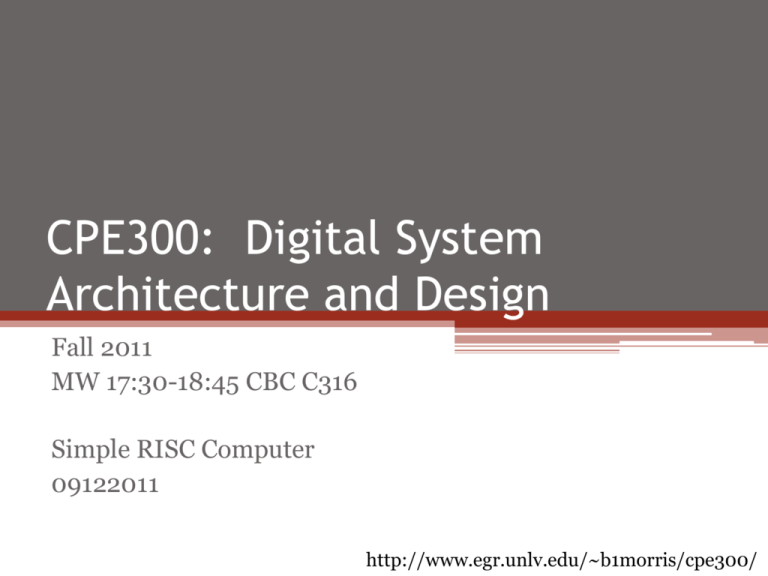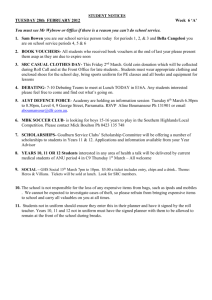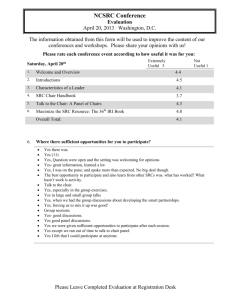CPE300: Digital System Architecture and Design
advertisement

CPE300: Digital System
Architecture and Design
Fall 2011
MW 17:30-18:45 CBC C316
Simple RISC Computer
09122011
http://www.egr.unlv.edu/~b1morris/cpe300/
2
Outline
•
•
•
•
Recap
Addressing Modes
Simple RISC Computer (SRC)
Register Transfer Notation (RTN)
3
3,2,1,& 0 Address Instructions
• 3 address instruction
▫ Specifies memory addresses for both operands
and the result
▫ R Op1 op Op2
• 2 address instruction
▫ Overwrites one operand in memory with the result
▫ Op2 Op1 op Op2
• 1 address instruction
▫ Single accumulator register to hold one operand &
the result (no address needed)
▫ Acc Acc op Op1
• 0 address
▫ Uses a CPU register stack to hold both operands
and the result
▫ TOS TOS op SOS (TOS is Top Of Stack, SOS is
Second On Stack)
4
Example 2.1
• Evaluate a = (b+c)*d-e
• for 3- 2- 1- and 0-address machines
• What is size of program and amount of memory
traffic in bytes?
5
Instructions
Example 2.1
3-Address
2-Address
1-Address
0-Address
add
load a, b
lda
b
push b
mult a, a, d
add
add
c
push c
sub
mult a, d
mult d
add
sub
sub
e
push d
sta
a
mult
a, b, c
a, a, e
a, c
a, e
push e
sub
pop
a
Bytes size
3-Address
2-Address
1-Address
0-Address
Instruction 30
28
20
23
Memory 27
33
15
15
Total 57
61
35
38
6
Fig. 2.8 General Register Machines
• Most common choice for general purpose
computers
• Registers specified by “small” address (3 to 6
bits for 8 to 64 registers)
▫ Close to CPU for speed and reuse for complex
operations
7
1-1/2 Address Instructions
• “Small” register address = half address
• 1-1/2 addresses
▫ Load/store have one long & one short address
▫ 2-operand arithmetic instruction has 3 half
addresses
8
Real Machines
• General registers offer greatest flexibility
▫ Possible because of low price of memory
• Most real machines have a mixture of 3, 2, 1, 0, 1-1/2
address instructions
▫ A distinction can be made on whether arithmetic
instructions use data from memory
• Load-store machine
▫ Registers used for operands and results of ALU
instructions
▫ Only load and store instructions reference memory
• Other machines have a mix of register-memory and
memory-memory instructions
9
Instructions/Register Trade-Offs
• 3-address machines have shortest code but large
number of bits per instruction
• 0-address machines have longest code but small
number of bits per instruction
▫ Still require 1-address (push, pop) instructions
• General register machines use short internal register
addresses in place of long memory addresses
• Load-store machines only allow memory addresses
in data movement instructions (load, store)
• Register access is much faster than memory access
• Short instructions are faster
10
Addressing Modes
• Addressing mode is hardware support for a useful
way of determining a memory address
• Different addressing modes solve different HLL
problems
▫ Some addresses may be known at compile time, e.g.
global vars.
▫ Others may not be known until run time, e.g. pointers
▫ Addresses may have to be computed
Record (struct) components:
variable base(full address) + const.(small)
Array components:
const. base(full address) + index var.(small)
• Possible to store constant values without using
another memory cell by storing them with or
adjacent to the instruction itself.
11
HLL Examples of Structured Addresses
• C language: Rec -> Count
▫ Rec is a pointer to a record: full address variable
▫ count is a field name: fixed byte offset, say 24
• C language: v[i]
▫ v is fixed base address of array: full address
constant
▫ i is name of variable index: no larger than array
size
• Variables must be contained in registers or
memory cells
• Small constants can be contained in the
instruction
• Result: need for “address arithmetic.”
▫ E.g. Address of Rec -> Count is address of
Rec + offset of Count.
Count
Rec
v[i]
v
12
Fig 2.9 Common Addressing Modes a-d
Two Memory Accesses!
13
Fig 2.9 Common Addressing Modes e-g
14
Simple RISC Computer (SRC)
• 32 general purpose registers (32 bits wide)
• 32 bit program counter (PC) and instruction
register (IR)
• 232 bytes of memory address space
• Use C-style array referencing for addresses
15
SRC Memory
• 232 bytes of memory address space
• Access is 32 bit words
▫ 4 bytes make up word, requires 4 addresses
▫ Lower address contains most significant bits
(msb) – highest least significant bits (lsb)
1000
W0
1001
W1
1002
W2
1003
W4
1004
1005
Bits
31
23
15
7
Address
1001
1002
1003
1004
Value
W0
W1
W2
W3
0
16
SRC Basic Instruction Formats
• There are three basic instruction format types
• The number of register specific fields and length
of the constant field vary
• Other formats result from unused fields or parts
17
Notice the unused space
Trade-off between
- Fixed instruction size
- Wasted memory space
Ch3 single instruction
per clock cycle
18
SRC Characteristics
• (=) Load-store design - only memory access through load/store
instructions
• (–) Operations on 32-bit words only (no byte or half-word
operations)
• (=) Only a few addressing modes are supported
• (=) ALU instructions are 3-registertype
• (–) Branch instructions can branch unconditionally or conditionally
on whether the value in a specified register is = 0, <> 0, >= 0, or <
0.
• (–) Branch-and-link instructions are similar, but leave the value of
current PC in any register, useful for subroutine return.
• (–) Can only branch to an address in a register, not to a direct
address.
• (=) All instructions are 32-bits (1-word) long.
(=) – Similar to commercial RISC machines
(–) – Less powerful than commercial RISC machines
19
SRC Assembly Language
• Full Instruction listing available in Appendix B.5
• Form of line of SRC assembly code
Label:
opcode
operands
;comments
• Label: = assembly defined symbol
▫ Could be constant, label, etc. – very useful but not
always present
• Opcode = machine instruction or pseudo-op
• Operands = registers and constants
▫ Comma separated
▫ Values assumed to be decimal unless indicated (B, 0x)
20
SRC Load/Store Instructions
• Load/store design provides only access to
memory
• Address can be constant, constant+register, or
constant+PC
• Memory contents or address itself can be loaded
Instruction
ld r1, 32
ld r22, 24(r4)
st r4, 0(r9)
la r7, 32
ldr r12, -48
lar r3, 0
op
1
1
3
5
2
6
ra
1
22
4
7
12
3
rb
0
4
9
0
–
–
c2
32
24
0
32
-48
0
Meaning
R[1] M[32]
R[22] M[24+R[4]]
M[R[9]] R[4]
R[7] 32
R[12] M[PC -48]
R[3] PC
Note: use of la to load constant
Addressing Mode
Direct
Displacement
Register indirect
Immediate
Relative
Register (!)
21
SRC ALU Instructions
Format
neg ra, rc
not ra, rc
add ra, rb, rc
sub ra, rb, rc
and ra, rb, rc
or ra, rb, rc
addi ra, rb, c2
andi ra, rb, c2
ori ra, rb, c2
Example
neg r1, r2
not r2, r3
add r2, r3, r4
addi r1, r3, 1
Meaning
;Negate (r1 = -r2)
;Not (r2 = r3´ )
;2’s complement addition
;2’s complement subtraction
;Logical and
;Logical or
;Immediate 2’s complement add
;Immediate logical and
;Immediate logical or
• Note:
▫ No multiply instruction (can be done based on addition)
▫ Immediate subtract not needed since constant in addi may be negative
(take care of sign bit)
22
SRC Branch Instruction
• Only 2 branch opcodes
br rb, rc, c3<2..0>
;branch to R[rb] if R[rc] meets
;the condition defined by c3<2…0>
brl ra, rb,
•
c3<2..0>,
lsbs
000
001
010
011
100
101
rc, c3<2..0>
;R[ra] PC, branch as above
the 3 lsbs of c3, that define the branch condition
condition
never
always
if rc = 0
if rc 0
if rc ≥ 0
if rc < 0
Assy language form
brlnv
br, brl
brzr, brlzr
brnz, brlnz
brpl, brlpl
brmi, brlmi
Example
brlnv r6
br r5, brl r5
brzr r2, r4
• Note: branch target address is always in register R[rb]
▫ Must be placed in register explicitly by a previous instruction
23
Branch Instruction Examples
Ass’y
lang.
brlnv
br
brl
Example instr. Meaning
op
ra
rb
brlnv r6
br r4
brl r6,r4
9
8
9
6
—
6
brzr
brzr r5,r1
8
brlzr
brnz
brlnz
brlzr r7,r5,r1
brnz r1, r0
brlnz r2,r1,r0
brpl
brlpl
brpl r3, r2
brlpl r4,r3,r2
brmi
brlmi
brmi r0, r1
brlmi r3,r0,r1
R[6] PC
PC R[4]
R[6] PC;
PC R[4]
if (R[1]=0)
PC R[5]
R[7] PC;
if (R[0]0) PC R[1]
R[2] PC;
if (R[0]0) PC R[1]
if (R[2]•0) PC R[3]
R[4] PC;
if (R[2]•0) PC R[3]
if (R[1]<0) PC R[0]
R[3] PC;
if (r1<0) PC R[0]
—
4
4
rc c3
2..0
— 000
— 001
— 001
Branch
Cond’n.
never
always
always
—
5
1
010
zero
9
8
9
7
—
2
5
1
1
1
0
0
010
011
011
zero
nonzero
nonzero
8
9
—
4
3
3
2
2
100
plus
plus
8
9
—
3
0
0
1
1
101
minus
minus
24
Unconditional Branch Example
• C code
▫ goto Label3
• SRC
lar r0, Label3
;load branch target address into register r0
br r0
;branch
…
Label3
…
;branch address
25
Conditional Branch Example
• C definition
#define Cost 125
if(X<0) x = -x;
• SRC assembly
Cost:
X:
Over:
.org 0
.equ 125
.org 1000
;define symbolic constant
;next word loaded at address 100010
.dw 1
.org 5000
;reserve 1 word for variable X
;program will be loaded at 500010
lar
ld
brpl
neg
;load address of false jump locations
;get value of X into r1
;branch to r0 if r1 >= 0
;negate r1 value
…
r0,
r1,
r0,
r1,
Over
X
r1
r1
26
Pseudo-Operations
• Not part of ISA but assembly specific
▫ Known as assembler directives
▫ No machine code generated – for use by
assembler, linker, loader
• Pseudo-ops
▫ .org = origin
▫ .equ = equate
▫ .dx = define (word, half-word, byte)
27
Synthetic Instructions
• Single instruction (not in machine language)
that assembler accepts and converts to single
instruction in machine language
▫ CLR R0
▫ MOVE D0, D1
andi r0, r0, 0
or
r1, r0, r0
(Other instructions possible besides and and or)
• Only synthetic instructions in SRC are
conditional branches
▫ brzr r1, r2
br
r1, r2, 010
if R[2] = 0
28
Miscellaneous Instructions
• nop – no operation
▫ Place holder or time waster
▫ Essential for pipelined implementations
• stop
▫ Halts program execution, sets Run to zeros
▫ Useful for debugging purposes
29
Register Transfer Notation (RTN)
• Provides a formal means of describing machine
structure and function
▫ Mix natural language and mathematical expressions
• Does not replace hardware description languages.
▫ Formal description and design of electronic circuits
(digital logic) – operation, organization, etc.
• Abstract RTN
▫ Describes what a machine does without the how
• Concrete RTN
▫ Describe a particular hardware implementation (how
it is done)
• Meta-language = language to describe machine
language
30
RTN Symbol Definitions (Appendix B.4)
Register transfer: register on LHS stores value from RHS
[]
Word index: selects word or range from named memory
<>
Bit index: selects bit or bit range from named memory
n..m
Index range: from left index n to right index m; can be decreasing
If-then: true condition of left yields value and/or action on right
:=
Definition: text substitution with dummy variables
#
Concatenation: bits on right appended to bits on left
:
Parallel separator: actions or evaluations carried out simultaneously
;
Sequential separator: RHS evaluated and/or performed after LHS
@
Replication: LHS repetitions of RHS are concatenated
{}
Operation modifier: information about preceding operation, e.g., arithmetic type
()
Operation or value grouping
=≠<≤≥>
Comparison operators: produce binary logical values
+-
Arithmetic operators
Logical operators: and, or, not, xor, equivalence
31
Specification Language Notes
• They allow the description of what without having to specify
how.
• They allow precise and unambiguous specifications, unlike
natural language.
• They reduce errors:
▫ errors due to misinterpretation of imprecise specifications written in
natural language
▫ errors due to confusion in design and implementation - “human
error.”
• Now the designer must debug the specification!
• Specifications can be automatically checked and processed by
tools.
▫ An RTN specification could be input to a simulator generator that
would produce a simulator for the specified machine.
▫ An RTN specification could be input to a compiler generator that
would generate a compiler for the language, whose output could be
run on the simulator.
32
Logic Circuits in ISA
• Logic circuits
▫ Gates (AND, OR, NOT) for Boolean expressions
▫ Flip-flops for state variables
• Computer design
▫ Circuit components support data transmission
and storage as well
33
Logic Circuits for Register Transfer
• RTN statement A B
34
Multi-Bit Register Transfer
• Implementing A<m..1> B<m..1>
35
Logic Gates and Data Transmission
• Logic gates can control transmission of data
36
2-Way Multiplexer
• Data from multiple sources can be selected for
transmission
37
m-Bit Multiplexer
• Multiplexer gate signals Gi may be produced by
a binary to one-out-of n decoder
▫ How many gates with how many inputs?
▫ What is relationship between k and n?
38
Separating Merged Data
• Merged data can be separated by gating at
appropriate time
▫ Can be strobed into a flip-flop when valid
39
Multiplexed Transfers using Gates and Strobes
• Selected gate and strobe determine which
Register is transferred to where.
▫ AC, and BC can occur together, but not AC,
and BD
40
Open-Collector Bus
• Bus is a shared datapath (as in previous slides)
• Multiplexer is difficult to wire
▫ Or-gate has large number of inputs (m x #gated
inputs)
• Open-collector NAND gate to the rescue
41
Wired AND Connection
• Connect outputs of 2 OC NAND gates
▫ Only get high value when both gates are open
42
Wired-OR Bus
• Convert AND to OR using DeMorgan’s Law
• Single pull-up resistor for whole bus
• OR distributed over the entire connection
43
Tri-State Gate
• Controlled gating
▫ Only one gate active at a time
▫ Undefined output when not active
44
Tri-State Bus
• Can make any register transfer R[i] R[j]
• Only single gate may be active at a time
▫ Gi ≠ Gj
45
Chapter 2 Summary
•
•
•
•
•
•
Classes of computer ISAs
Memory addressing modes
SRC: a complete example ISA
RTN as a description method for ISAs
RTN description of addressing modes
Implementation of RTN operations with digital
logic circuits
• Gates, strobes, and multiplexers






